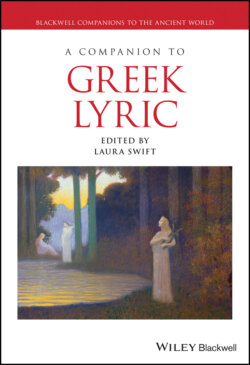Читать книгу A Companion to Greek Lyric - Группа авторов - Страница 36
VI Love and War 1: Helen in Sappho and Alcaeus
ОглавлениеGiven the general lyric tendency toward selectivity, myths may merely be summarized, as in the story of Eos and Tithonos examined earlier. Consider, too, the famous deployment of Helen’s story in Sappho fr. 16.1–20, where Sappho has little interest in retelling several episodes from the war, rather than boiling down one central event, Helen’s abandonment of her family.28 She uses for this poem her characteristic “Sapphic” stanza, in which the first three verses are always eleven syllables long (unlike the epic verse, whose syllable count can vary29) but which, like the hexameter, can form potentially self-contained lines, while the final verse (the so-called “adonean” clausula) is treated as a continuous element of the previous verse. The stanza, once more, is a semantic unit: e.g., the delayed main verb “she went” (ἔβα 9) at the start of the third stanza—the only such run-over example in the preserved portion of the poem—underlines the obvious importance of that act to the eventual fate of her husband, to Troy, and indeed to Sappho’s own situation. One may even suspect an intentional play on the promised ease of demonstration at the start of the second stanza (“it is very easy to make this [viz, the substance of lines 3–4, below] well understood” 5–6), which proves unable to be completed until the third.
The rhythmic difference with the dactylic hexameter is noticeable (the first three verses have the invariable pattern ‒ ˘ ‒ × ‒ ˘ ˘ ‒ ˘ ‒ ‒), but the fourth verse (‒ ˘ ˘ ‒ ‒) exactly matches a common line-end pattern in the hexameter, and therefore frequently contains epic forms.30 Indeed, scholars have detected several more or less direct adaptations, with, e.g., [ο]ἰ μὲν ἰππήων στρότον, οἰ δὲ πέσδων (1) and ἐπ[ὶ] γᾶν μέλαι[ν]αν (2) perhaps copying the Homeric formulae πέζοι θ’ ἱππῆές τε (3x) and γαῖα μέλαινα (8x). But the second of these is also a topos in lyric poetry (e.g., Sappho frr. 1.10, 20.6, Alcaeus fr. 283.13–14 [below]), so that we have to reckon also with the shaping of a lyric tradition.
Sappho’s invocation of Helen’s story here is introduced (once again) swiftly, though this time to justify the primacy of “whatever one loves” (3–4) over the material of war (1–3), and this opposition has been held by some scholars, too readily, as straightforwardly programmatic of a lyric versus an epic sensibility.31 As Helen becomes the model for the principle, however, the poem begins to cast doubt on whether love is so separate from the military items in the priamel, and when Sappho relates the absence of Helen to that of her beloved Anactoria (15–16), the reader realizes with a shock that she is now comparing herself to Menelaus, a man prepared to bring war to the entire Greek world to recover his lost wife. The clever play on our expectations puts the surface aim of the poem in a discernible tension with its paradigmatic myth: love and war—perhaps lyric and epic as well—are not so mutually exclusive or antagonistic, after all.32 Thus, the poem meditates on the nature of modal relationships, or rather their interrelationship.
Sappho’s treatment of Helen is certainly more subtle, even sympathetic, than Alcaeus’ ringing damnation of the same figure in fr. 42, which seems to lack any explicit connection to the poet’s world, and simply to compare her (1–4, 15–16) to the goddess Thetis, whose love with Peleus brought into the world something great and good in the form of Achilles (5–13).33 Alcaeus mentions Thetis also in fr. 44, where he may invoke and crystallize the same story as the Iliad, though the poem’s fragmentary state makes it very hard to say anything at all about the way in which this epic treatment is invoked and recreated—beyond the fact that it is very short indeed.34 At slightly more length, Alcaeus returns to Helen again in fr. 283.3–18 (1–2 cannot be reconstructed), where the evaluative coloring of the myth is clear throughout:35 Helen’s heart has been made to flutter (3), the liaison’s inappropriateness is made clear by the juxtaposition of Ἀργείας, Τροΐ̣ω (4), she is maddened (5), she abandons her child (7) under the influence of Zeus’ child (10, possibly Aphrodite), she remains responsible in the adonean (ἔν]νεκα κήνας 14), and the anaphora of πολλ- (15, 16), together with the shift into past tenses and the application to the chariots of the usually personal epic verb ἤριπεν (16), underlines the disastrous results of her action. We have no way of knowing how long this poem was, but Alcaeus’ negative judgment of Helen dominates the selection and sequencing of the story, i.e., from her following Paris (3–6), abandoning her home (7–10), and then causing destruction (11–16f.). Similarly evaluative coloring is of course found in epic poetry, but the narrative in the latter is typically more full, more clearly progressive and sequential. Consider, for example, Agamemnon in the Underworld when relating (through Odysseus) his death (Od. 11.409–26), which is told both to answer Odysseus’ query about what had happened (397–403) and, more explicitly, to illustrate the treachery of womankind (427–434): though the behavior of Clytemnestra is clearly negatively formed, the story is given in full, and includes Aigisthos’ behavior, the death of his comrades, of Cassandra, and Clytemnestra’s poor treatment of her husband. The wider narrative context, once more, sits together with epic’s ability or tendency toward more capacious and progressive storytelling.
